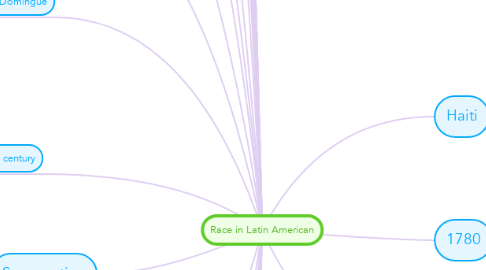Race in Latin American
by maricela flores

1. Haitian Revolution
1.1. black liberation was possible in the historical time
1.2. emancipation debate from the British parliamentary move in 1792 to outlaw the African slave trade to Brazil final abolition of slavery
1.3. the American slave trade in 1808 the earliest date allowed by the constitution
1.4. crucial votes in 1806 abolishing the slave trade to rival foreign markets
2. Brazil
2.1. have more African slaves than any other country in the American
2.2. 1870 the Brazilian elite came
2.3. now had focus on race not slavey
2.4. became an empire with a monarchy
3. abolition
3.1. it took long until 1888
3.2. slavery was not abolished until 1853
3.3. believe that slavery was a moral, economic and political
4. Brazilian Intellectual
4.1. whitening ideology accepted the mulatto but not the black
4.2. the problem of race 1870 -1930
4.3. connected north American social behavior with racist theory morally and emotionally repugnant
5. miscegenation
5.1. Brazil became a true community of people representing very diverse ethnic origins
5.2. marriage or cohabitation between two people from different racial groups
6. 1930
6.1. Jim Crow system lost the intellectual sanction by racist theory
7. Modernization
7.1. the cost of living, the loss of land, proletarianization and exploitation
7.2. most of Hispanic America entered a period of economic growth in the end of nineteenth century
8. Cuba
8.1. achieved independence fromSpain in 1898
8.2. Afro-Cuban Intellectual thought the nineteenth century
8.3. black and mulattoes where called in cuba
8.4. Afro-Cuban as slave economy
9. late 1880
9.1. blacks and Indians became insignificant minorities and immigration became a major social issue
10. Fernandez Ortiz
10.1. well know as the first Cuban ethnologist and as an antiracist
10.2. African were inferior because of their lack of integral civilization and moral
10.3. belonged to the progressive line of the liberals
10.4. he saw the three races white, black , and yellow
10.5. he built his theory of Afro Cuban criminality
11. Segregation
11.1. it didn't disappear and racism turn against a new scapegoat the black Haitian and Jamaican immigrants
12. late eighteenth century
12.1. Indian meant more as a fiscal category than as an ethnic one
13. Saint Domingue
13.1. gave an immense stimulus to plantation slavery from neighboring Cuba to far off Brazil
14. the whitening thesis
14.1. unique support in Brazil support from the widespread belief
14.2. 1920 receive its most systematic statement
15. Black power movement
15.1. primarily in Rio De Janeiro, in the late 1970 prevalent myth of racial democracy
16. Zapatismo
16.1. it is important, is link to the Indian cause by outraged planters
17. Indigenismo
17.1. Mexican Elites
17.2. elite formulation of the Indian problem
18. Enlightened
18.1. by the end of the 18th century many elites in colonized American so it turn into enlightened
18.2. provide ideas behind the social, economic and political revolution of the 18th and 19th century
18.3. a new political ideology came to the fore, the belief was personal liberties
18.4. the ages that defined racial difference battle of the sexes
19. The Indian
19.1. were denied education, political access, and economic development
19.2. were considered the most enemy of Argentinean civilization until the early 1880
19.3. black and Indian became insignificant minorities and immigration became a major social issue
19.4. could become mestizos
19.5. were discriminated against for being Indian and at the same time admire for being real soul of Mexican
20. Argentina
20.1. it the most European of Latin American
20.2. African slaves were first brought in 1770
20.3. 1900 almost complete one century of independence
20.4. were becoming European white races
20.5. many immigrants came they were welcome to cheap labor, new social group, farmers, and urban middle classes
21. Anglo Saxon
21.1. The indian had been pushed aside and the black segregated
21.2. appeared at the top of the racial scale
22. colonial Miscegenation
22.1. the formation of a white nation by at least a century
23. 1860
23.1. the end of slave trade
24. late eighteenth century
24.1. Indian meant more as a fiscal category than as an ethnic one
25. the little war of 1912
25.1. perpetual and implacable struggle between races that never could mix
25.2. white resentment resulted in the massacre of 1912
26. census 1940
26.1. Brazil population was growing whiter
27. 1821
27.1. Mexican independence
28. Mexican
28.1. were pure Indian or whites criollo/creoles
28.2. the population was Indian at the time of the Revolution
29. the Revolution
29.1. began in 1910
29.2. work of two social classes, two races and outcome nationwide
30. lower class of society
30.1. American Indians, African and mestizo. the elites did not grant them political rights
31. subjective nature of Indian/mestizos status
31.1. subjective of the community
31.2. a community is Indian it considers itself Indians, they belong to an Indigenous community
32. Haiti
32.1. 1 January 1804 declared the independence of the Republic of Haiti
32.2. independence spread to others american cities
33. 1780
33.1. Saint -Domingue was the centerpiece of the Atlantic salve system
34. Haitian birth
34.1. the new world slavery transformed in the Age of revolution


